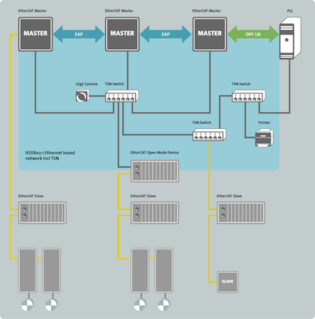
by Gary Mintchell | Jan 31, 2018 | Automation, Networking, Standards, Technology
Time Sensitive Networking (TSN) defines the future of networking. Most of the specifications have been agreed upon by the IEEE 802 committee, only a few remain to be completed. I have written a White Paper describing OPC UA over TSN for information communication. This corroborates the idea that information is where the new momentum lies within manufacturing and production technologies.
One topic of concern to many regards whether or not TSN will supplant current fieldbus technologies. Indeed, on the surface it appears that TSN can perform most, if not all, of those functions.
Therefore, it behooves the fieldbus groups to figure out how to work with this new technology in order to add value for users.
The EtherCAT Technology Group (ETG) has taken the initiative and supplemented EtherCAT with Time Sensitive Networking (TSN) technologies, expanding the field of possible EtherCAT applications to include heterogeneous network environments. With the help of TSN, industrial controls can contact a number of different EtherCAT segments in real-time through Ethernet networks.

In doing so, no changes to the EtherCAT slave devices are required: the EtherCAT Device Protocol, including all high performance characteristics, is fully preserved. Also expanded by TSN is the EtherCAT Automation Protocol (EAP) for communication between controls, which will result in even more deterministic performance on this level.
The ETG has specified the technology expansion in the form of a profile, which highlights the fact that no changes to the TSN standards are needed. This approach also considerably simplifies the adaptation to the final versions of the TSN technologies, because specification in the IEEE is not yet fully complete.
The ETG has supported the development of TSN from the very beginning through active participation in the IEEE committee, and is coordinating the specifications through a liaison with the IEEE 802.1 Working Group. This ensures that the ETG will also be able to access the IEEE 802.1 specifications that have not yet been adopted. Therefore, the technology can be introduced almost at the same time as TSN.
EtherCAT uses the TSN streams with any data rates for real-time communication above EtherCAT device segments. In the segment itself nothing is changed – the unique performance of the EtherCAT protocol built upon processing on the fly, highly precise synchronization, flexible topology selection, excellent diagnostic capabilities and simplicity through fully automated addressing of devices are all fully preserved. Similarly, the thousands of different EtherCAT devices available worldwide do not need to be modified at all. The stream adaptation feature that connects the EtherCAT segment to the heterogeneous TSN network can be placed either in the last TSN switch or in the first EtherCAT slave device.
Dr. Guido Beckmann, Chairman of the ETG Technical Committee classifies the new specification as such: “The incorporation of TSN standards will significantly improve the real-time characteristics of generic Ethernet. With our technology expansion we make use of TSN in an ideal way, and exactly where TSN can offer significant advantages – in the factory networks. As one frame is sufficient for EtherCAT to communicate with a whole segment, and thus with the entire fieldbus network, EtherCAT is virtually predestined for integration with TSN networks. We achieve this without turning our technology inside out. EtherCAT together with TSN offers the ‘best of both worlds’. Therefore, this prepares EtherCAT for the future perfectly.”

by Gary Mintchell | Aug 1, 2014 | Automation, News, Operations Management, Organizations, Technology
Even organizations are not immune from the consolidation bug. It had been previously announced that, given a couple of transitions and the similarity of membership and technology, industrial networks organizations the Fieldbus Foundation and the HART Communication Foundation would investigate merger.
Here is the latest news. An unstated reason is significant along with emphasizing a statement within the press release. First, there are leadership changes. Ron Helson, the longtime leader of HART recently retired. I have to believe that Rich Timoney, the longtime Fieldbus leader, is preparing to retire (conjecture on my part, I dont want to rush him). This becomes convenient timing.
Further, look for the sentence “suppliers will also profit.” This is significant. The two organizations have significant overlap, yet basically the same set of suppliers support each. By combining, suppliers can get more return from less investment. Since both technologies are pretty mature and stable, this makes a lot of sense.
The Boards of Directors of the Fieldbus Foundation and the HART Communication Foundation have approved unifying the two Foundations into a new industry organization. The joint statement said the new organization would be “dedicated to the needs of intelligent devices and their integration in the world of Process Automation.”
The combined power of both organizations will serve to protect the investments that end users in Process Automation have made in HART and FOUNDATION fieldbus communication technologies. The mission of the combined organization will be to develop, manage, and promote global standards for integrating devices into automation-system architectures, providing functional solutions for process automation suppliers and end users. Suppliers will also profit from the increased efficiencies in resource utilization, procedure consistency, and member service and support improvements.
The Fieldbus Foundation and HART Communication Foundation have a long history of cooperation. For example, the two worked together to develop common international standards, such as Electronic Device Description Language (EDDL) specifications and Field Device Integration (FDI) technology. Combining the organizations offers significant potential for harmonizing the procedures and efforts supporting the two protocols, as well as simplifying each technology’s implementation while better delivering their full benefits in plant operation and maintenance.
The FOUNDATION fieldbus and HART specifications will continue to exist individually, and to evolve into the future. Each protocol will retain its own brand name, trademarks, patents, and copyrights.
The new organization will continue development, support, and promotion of the two existing protocols, and will direct the development, incorporation, and implementation of new and overlapping technologies. Thus, the new organization will eventually serve as the single source for FDI, the sole integration tool for HART and FOUNDATION fieldbus technologies. The name of the proposed organization is not yet finalized.
The next step will be to complete the membership ballot by the end of summer 2014. Following a successful membership vote, legal filings for the creation of a new not-for-profit entity will take place in September 2014. As a final step, it is expected that the new organization offices will be consolidated and located near Austin, Texas, in early 2015.
The leadership of Helson and Timoney cannot be overstated. Their contributions to industrial automation are significant. Many thanks are due them.

by Gary Mintchell | Sep 29, 2013 | Automation, Technology

Mike Bryant, Executive Director PI NA
The 19th annual general annual meeting of PI North America in Phoenix wrapped up on Thursday September 26. Michael Bryant, executive director, remarked that plans for a 20th anniversary celebration next yea are already in the works. In his opening remarks, Bryant pointed to independent analysts who anoint leading market positions in North America to Profibus and Profinet technologies.
The purposes of these meetings include updating members on changes in the standards, marketing plans, and sharing stories about customer successes with Profibus and Profinet.
Four board members representing Siemens, GE Intelligent Platforms, Endress + Hauser and Phoenix Contact shared why their companies support “All Things Profi.” Scalability and flexibility of implementation was most often cited as reasons customers like Profibus and Profinet.
Profibus is the device-level network—the original fieldbus in the standard. Profibus PA is an implementation of the standard specifically for process automation. Profinet is the Ethernet implementation that comes in three flavors that support standard Ethernet for general purpose device networking and two types of real-time, deterministic implementations for applications such as coordinated motion control.
Fieldbus technologies (a specific form of industrial networks) were originally touted a method to reduce wiring costs and reduce installation time. Users quickly discovered that the number one benefit was availability of device and system diagnostics. These quickly earned favor with electricians and other maintenance technicians when they discovered the time savings, as well as savings in the grief of prolonged trouble-shooting, provided. This fact merited a feature presentation on diagnostic information and tools available with Profibus and Profinet.
Presentations on using Profinet on off-shore oil rigs and using Profibus in the production of spirits at Jim Beam brought a final user focus to members.









